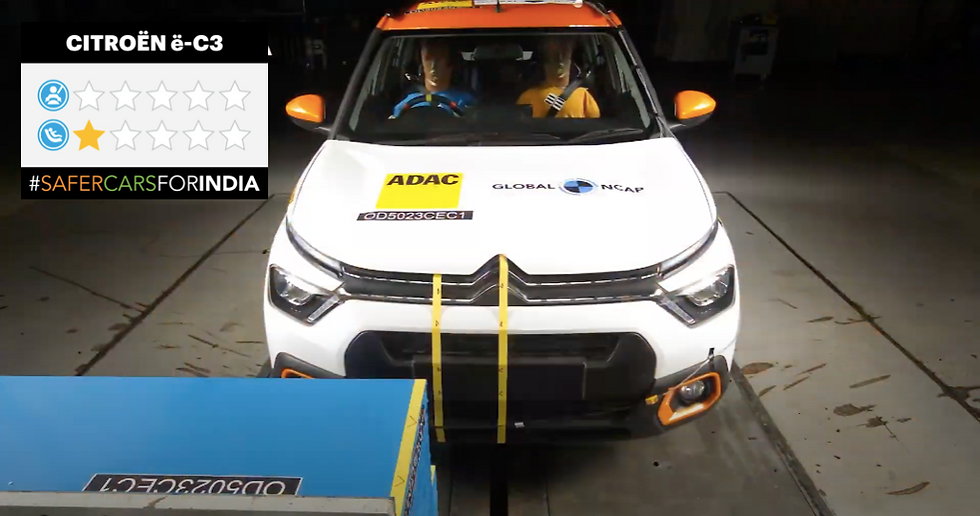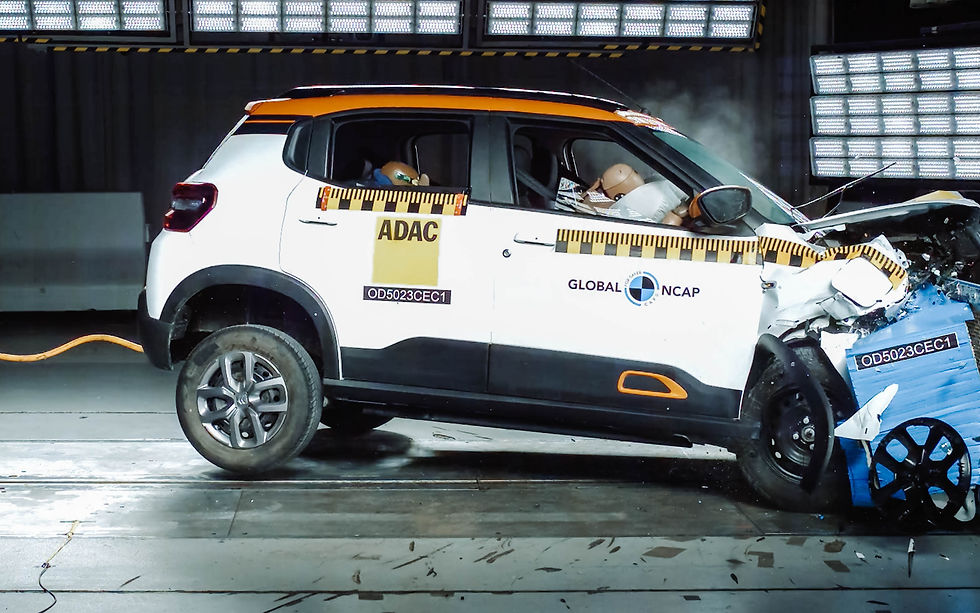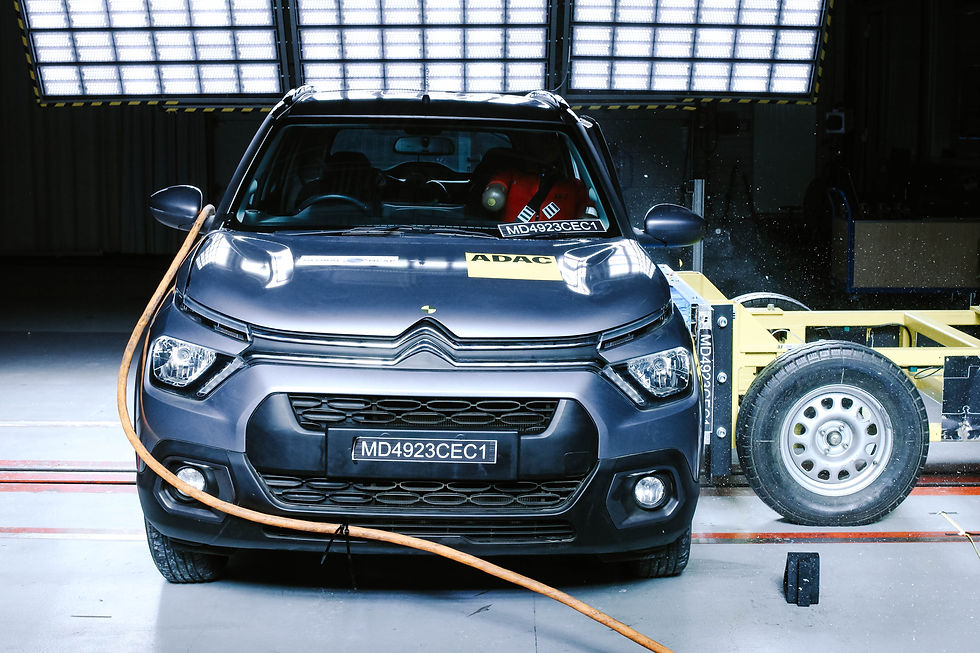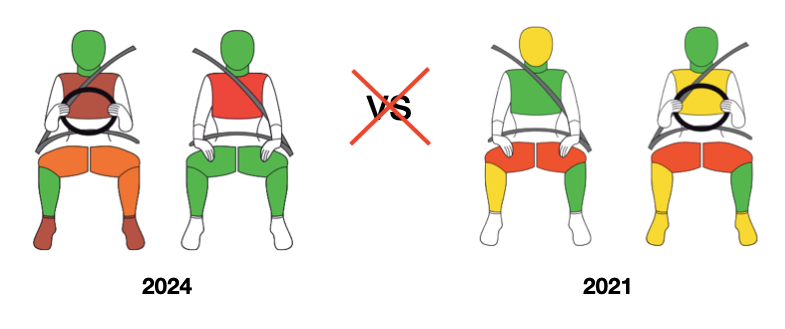Global NCAP: Safety Back to Basics with Citroën ë-C3
- Gobar NCRAP
- Mar 22, 2024
- 5 min read
Updated: Mar 22, 2024

Earlier today, UK-based consumer organisation Global NCAP announced the latest results of its #SaferCarsForIndia consumer safety testing campaign, awarding Citroën's new electric ë-C3 city hatchback no stars for adult occupant protection and only one (of the maximum five) for child occupant protection.
The ë-C3 offers arguably the least competitive level of safety equipment in its class, and Global NCAP's results suggest that also applies to its crash protection. (Related: see how the ë-C3's safety equipment falls behind most of India's other city cars) It lacks active safety features like electronic stability control and rear seatbelt reminders -- now common in its class -- as well as crash protection features like seatbelt pretensioners, side airbags, ISOFIX anchorages and a three-point seatbelt in the rear centre seat. Particularly surprising is the fact that some of these features are standard equipment on the petrol version sold in other countries like Brazil.
Test Summary
Frontal impact
The ë-C3 was put through a front offset deformable barrier test carrying adults in the front seat and children in the rear, in child restraints selected by Stellantis.

Test speed | 64 ± 1 km/h |
Target | Deformable aluminium honeycomb barrier striking 40% of the width of the car |
What it represents | Crashing head-on at 50km/h into a car of similar dimensions, also travelling at 50km/h with half its width overlapping |
Driver | Hybrid III 50th percentile male, belted (dummy representing average European adult male) |
Front passenger | Hybrid III 50th percentile male, belted (dummy representing average European adult male) |
Rear seat, driver side | Q3 (three year-old child dummy) Child restraint: Joie Tilt, forward-facing (belted) |
Rear seat, passenger side | Q1.5 (18 month-old child dummy) Child restraint: Joie i-Gemm, rearward-facing (belted) |
In the frontal offset test, the airbags deployed correctly and readings of deceleration of the driver and passenger's heads showed negligible risk of serious skull fracture. However, readings of compression of the driver and passenger's ribs indicated a somewhat high risk of fracture. What's more, loadcells installed on the seatbelt above the front passenger's shoulder recorded excessive forces exerted on his chest by the shoulder portion of the belt, and for this the front passenger's chest score was marked down, with protection being rated as poor (this limits the overall result to one star). Although dummy readings showed good protection of the driver's knees, hard structures behind the fascia were deemed to threaten the protection of those of occupants of different sizes or seating positions, and the ë-C3 was penalised accordingly. The footwell ruptured and the pedals were driven backwards considerably, leading to protection of the driver's feet being rated weak.
The three year old child wasn't awarded any points for dynamics because, according to Global NCAP, the ë-C3's owners' manual deems that position unsuitable for transporting children in a belted child restraint. Even the child restraint used couldn't keep forward head excursion within the permissible 55cm limit, and the dummy's head made hard contact with parts of the vehicle interior. The 18 month-old child was very well-protected in comparison.
Side impact
The ë-C3 was put through a side impact test with a mobile barrier striking its passenger-side, carrying an adult male front passenger and children in the rear.

Test speed | 50 ± 1 km/h |
Target | Advanced 2000 (ECE95) 950kg side impact barrier striking front passenger's door |
What it represents | Being struck laterally at 50km/h by a small car on the front door, with no occupant on the "far side" |
Driver | none |
Front passenger | EuroSID II 50th percentile male (side impact dummy representing average European adult male) |
Rear seat, driver side | Q3 (three year-old child dummy) Child restraint: Joie Tilt, forward-facing (belted) |
Rear seat, passenger side | Q1.5 (18 month-old child dummy) Child restraint: Joie i-Gemm, rearward-facing (belted) |
In the test, there was hard contact of the adult dummy's head with the window frame -- the ë-C3 does not have curtain airbags -- and injury parameters based on acceleration showed that there was a considerable risk of serious, severe or critical skull fracture. Dummy readings for other body parts showed a low or limited risk of serious injury.
In the side impact, although the three year-old child was well-protected, it could not be awarded points because of aforementioned reasons, and Global NCAP says the 18 month-old child's head was exposed.
Overall rating
The poorly protected front passenger's chest limited the result to one star, and weirdly (also seen with other tests like the Maruti Suzuki Wagon R and Swift), Global NCAP decided to apply the additional penalty for difference in front and side impact scores after capping the result, resulting in a zero-star rating for adult protection.
Besides protection of child occupants in dynamic testing, Global NCAP also attempted to safely install a number of child restraints in the ë-C3's rear seats, where it lost most available points thanks to the lack of a three-point seatbelt in the rear centre seat and the fact that the ë-C3's owners' manual doesn't endorse installation of belted child restraints on the rear right-side seat. Global NCAP reviewed the safety features the ë-C3 offers to transport children safely and deemed them poor, thanks mostly to the static lapbelt in the rear centre seat and also due to the lack of ISOFIX anchorages and other child-friendly safety features. For example, the ë-C3 doesn't offer a switch to deactivate the front passenger's airbag should a parent want to install a rearward-facing child restraint there. However, a sunvisor label was judged to sufficiently indicate the risk of death or serious injury associated with installing a rearward-facing child restraint on a seat with an active airbag. Adding up all points, the ë-C3 was awarded one star for child occupant protection.
Why zero stars: the culprit
Before a star reduction for very different front and side impact scores (section 6.4.2 of Global NCAP's new protocols), the ë-C3 was initially capped at one star, not zero.
In fact, that's what the technical report confirms.
passenger’s chest showed poor protection limiting the result to one star
And poor protection leads to one star (not zero) only when dummy readings alone don't indicate poor protection but additional penalties do (3.1).
Capping can be reached by biomechanical value reading (in this case the result is capped to zero stars) or when one critical body region scores zero after modifiers are applied (in this case the result is capped to one star).
So, evidently, the "red" chest in the ë-C3 is not based on dummy readings alone but is because of some additional penalty.
The possible front passenger chest penalties are (new protocols -> 3.2.2):
-unstable passenger compartment
-hinge-pillar intrusion
-seatbelt loads
We can rule out the first two based on the technical report.
That leaves high seatbelt loads, quite likely too because the ë-C3 has no seatbelt pretensioners.
A seemingly small change in the assessment made the ë-C3 lose up to 2 out of 4 points for the chest because of high seatbelt loads, have its chest painted red (cap: ≤1 star) and also attract a penalty 6.4.2 (-1 star) resulting in zero stars.
Here's the kicker
The seatbelt load penalty was not part of Global NCAP's old protocols!
Despite the frontal impact test setup being common across old and new GNCAP protocols, the single frontal impact penalty that started the chain reaction that brought the ë-C3 down to zero stars was simply missing from GNCAP assessment before 2022.
With ever-changing assessment criteria it's tempting to pick out just the common test(s) like frontal impact to compare cars rated before and after 2022. But before you think of going and comparing the ë-C3's frontal impact with a rival tested earlier, keep in mind that there are subtle changes like this one and more that make a big difference. Many cars with good scores before 2022 had no seatbelt pretensioners, or pretensioners only for the driver.
Do not compare even just frontal impact scores and colours between old and post-2022 results








Comments